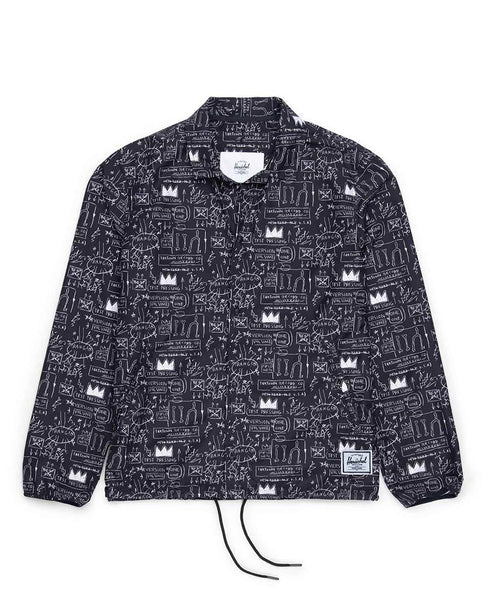editorial
Jean-Michel Basquiat on How to Be an Artist

Jean-Michel Basquiat wasn’t a fan of interviews, and on the rare occasions he surrendered to them, his responses were terse—even cryptic. Despite this, the painter’s words reveal a great deal about his inspirations and his all-consuming process. They offer a window into his approach, in which he remixed references from art history, the streets of 1980s New York, and the tumult of pop culture with his Carribean heritage and his identity as a young black man.
In a unique television interview with ART/new york from early 1981, when Basquiat was 21 years old, curator Marc H. Miller asked the painter where the poetic smattering of words scrawled on his canvases came from. Standing in front of his 1983 masterpiece Notary, he answered succinctly: “Real life, books, television.” When pressed for more, he acknowledged the importance of spontaneity to his practice: “When I’m working I hear them, you know, and I just throw them down,” he said of the words.

But Basquiat’s work was also deeply thoughtful—the products of his ravenous observations of the world around him. “I don’t think about art while I work,” he told writer Isabelle Graw in 1986. “I try to think about life.”
While Basquiat only survived to be 27 years old, passing away in 1988 due to drug overdose, he left behind a body of work that indelibly transformed painting. He also gave us a series of interviews (however short-winded) that offer profound glimpses into his artistic development and drive. Below, we share some of the painter’s most inspiring words.
While Basquiat never received a formal art education, he studied art history voraciously from a young age. Growing up in Park Slope, Brooklyn, his mother regularly carted him to the encyclopedic Brooklyn Museum, where he became card-carrying “junior member” at the tender age of six. As he grew older, Basquiat didn’t take to traditional education, hopping from school to school until finally dropping out after his junior year of high school. Instead, he preferred to self-educate. “I never went to an art school. I failed the art courses that I did take in school,” the painter later recalled. “I just looked at a lot of things. And that’s how I learnt about art, by looking at it.”
Later, with fellow graffiti writer and musician Fred Braithwaite—who went by the better-known moniker Fab 5 Freddy—Basquiat formed his “museum club.” The pair took weekly visits to museums across the city. “We’d go up to the Metropolitan Museum and act like we were art students,” Braithwaite remembered in an interview for Jean-Michel Basquiat: 1981: the Studio of the Street. “We would take out drawing pads and walk around making sketches of stuff that we thought was cool.”

Despite Basquiat’s criticisms of the art establishment, he admired scores of its most renowned artists, routinely citing Robert Rauschenberg and Andy Warhol as his idols. He was particularly fascinated with Warhol, who had also transformed the course of art and how it was valued by launching Pop Art. Another stage of Basquiat’s ad-hoc art education developed after he boldly introduced himself to Warhol, on a stroll through Soho in the late ’70s. That decision would lead Basquiat to his most influential mentor.
At the time, Basquiat was peddling painted postcards and tee-shirts to help make ends meet, ferrying them wherever he went. On one fateful day, he spotted Warhol and Henry Geldzahler, the Met’s influential curator of American art, through the window of the hip Prince Street watering hole WPA. “Jean is walking by with postcard-size things—like an intermediate step from graffiti into the world of galleries…,” Geldzahler recalled to Phoebe Hoban, in her 1998 biography Basquiat: A Quick Killing in Art. “And he notices Andy, so he comes in and he shows Andy the work.” While Geldzahler immediately dismissed Basquiat as “too young,” Warhol bought a postcard for $1, jumpstarting a significant relationship between the two artists.

Not long after, Warhol became a champion of Basquiat’s early paintings, introducing the young artist and his work to his vast network of influential artists, writers, curators, and gallerists. They developed both a productive professional relationship and a deep friendship. “I’d never seen Andy so close with anyone, and I’d never seen Jean so close with anyone—these guys really loved each other,” recalled dealer and curator Jeffrey Deitch.
Warhol’s diaries are chock full of references to Basquiat—trips to his studio, dining at the Odeon in tandem, attending a Boy George concert together. By 1985, the two artists were collaborating on a series of work for the exhibition “Warhol/Basquiat Paintings,”in which, as Basquiat recalled in his interview with Davis and Johnston, “[Warhol] would put something very concrete or recognizable, like a newspaper headline or a product logo, and then I would sort of deface it.” While the two artists had a falling out over the exhibition—Basquiat became angry when he was referred to as Warhol’s sidekick by the press—the younger artist was devastated by Warhol’s death in 1987.
Editorial and Images by Alexxa Gotthardt
